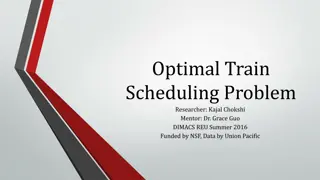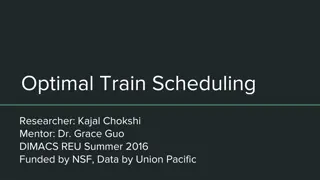
Network Coding Impact on Combinatorial Optimization
Explore the impact of network coding on combinatorial optimization, highlighting its benefits, applications, and algorithms. Discover the advantages of network coding over routing, algebraic algorithms for connectivity, and various scenarios where network coding excels. Dive into the significance of max-flow min-cut theorem in directed graphs and its implications on information capacity.
Download Presentation

Please find below an Image/Link to download the presentation.
The content on the website is provided AS IS for your information and personal use only. It may not be sold, licensed, or shared on other websites without obtaining consent from the author. If you encounter any issues during the download, it is possible that the publisher has removed the file from their server.
You are allowed to download the files provided on this website for personal or commercial use, subject to the condition that they are used lawfully. All files are the property of their respective owners.
The content on the website is provided AS IS for your information and personal use only. It may not be sold, licensed, or shared on other websites without obtaining consent from the author.
E N D
Presentation Transcript
Impact of Network Coding on Combinatorial Optimization Chandra Chekuri Univ. of Illinois, Urbana-Champaign DIMACS Workshop on Network Coding: Next 15 Years December 16, 2015
Network Coding [Ahlswede-Cai-Li-Yeung] Beautiful result that established connections between Coding and communication theory Networks and graphs Combinatorial Optimization Many others
Combinatorial Optimization Good characterizations via Min-Max results is key to algorithmic success Multicast network coding result is a min-max result
Benefits to Combinatorial Optimization My perspective/experience New applications of existing results New problems New algorithms for classical problems Challenging open problems Interdisciplinary collaborations/friendships
Outline Part 1: Quantifying the benefit of network coding over routing Part 2: Algebraic algorithms for connectivity
Coding Advantage Question: What is the advantage of network coding in improving throughput over routing?
Coding Advantage Question: What is the advantage of network coding in improving throughput over routing? Motivation Basic question since routing is standard and easy To understand and approximate capacity
Different Scenarios Unicast in wireline zero-delay networks Multicast in wireline zero-delay networks Multiple unicast in wireline zero-delay networks Broadcast/wireless networks Delay constrained networks Undirected graphs vs directed graphs
Max-flow Min-cut Theorem [Ford-Fulkerson, Menger] 1 G=(V,E) directed graph with non-negative edge-capacities 4 10 8 max s-t flow value equal to min s-t cut value t s 2 0 11 if capacities integral max flow can be chosen to be integral 6 Min s-t cut value upper bound on information capacity No coding advantage
Edmonds Arborescence Packing Theorem [Edmonds] G=(V,E) directed graph with non-negative edge-capacities A s-arboresence is a out-tree T rooted at s that contains all nodes in V Theorem: There are k edge-disjoint s-arborescences in G if and only if the s-v mincut is k for all v in V Min s-t cut value upper bound on information capacity No coding advantage for multicast from s to all nodes in V
Enter Network Coding Multicast from s to a subset of nodes T [Ahlswede-Cai-Li-Yeung] Theorem: Information capacity is equal to min cut from s to a terminal in T What about routing? Packing Steiner trees How big is the coding advantage?
Multicast Example s s can multicast to t1 and t2 at rate 2 using network coding b1 b2 b1 b2 Optimal rate since min-cut(s, t1) = min-cut(s, t2) = 2 b1 b2 b1+b2 Question: what is the best achievable rate without coding (only routing) ? b1+b2b1+b2 t1 t2
s s s A1 A2 A3 t1 t2 t2 t1 t1 t2 A1, A2, A3 are multicast/Steiner trees: each edge of G in at most 2 trees Use each tree for the time. Rate = 3/2
Packing Steiner trees Question: If mincut from s to each t in T is k, how many Steiner trees can be packed? Packing questions fundamental in combinatorial optimization Optimum packing can be written as a big LP Connected to several questions on Steiner trees
Several results/connections [Li, Li] In undirected graphs coding advantage for multicast is at most 2 [Agarwal-Charikar] In undirected graphs coding advantage for multicast is exactly equal to the integrality gap of the bi-directed relaxation for Steiner tree problem. Gap is at most 2 and at least 8/7. An important unresolved problemin approximation. [Agarwal-Charikar] In directed graphs coding advantage is exactly equal to the integrality gap of the natural LP for directed Steiner tree problem. Important unresolved problem. Via results from [Zosin-Khuller, Halperin etal] coding advantages is (k ) or (log2 n) [C-Fragouli-Soljanin] extend results to lower bound coding advantage for average throughput and heterogeneous settings
New Theorems [Kiraly-Lau 06] Approximate min-max theorems for Steiner rooted- orientation of graphs and hypergraphs [FOCS 06, Journal of Combinatorial Theory 08] Motivated directly by network coding for multicast
Multiple Unicast G=(V,E) and multiple pairs (s1, t1), (s2, t2), , (sk, tk) What is the coding advantage for multiple unicast? In directed graphs it can be (k) [Harvey etal] In undirected graphs it is unknown! [Li-Li] conjecture states that there is no coding advantage
Multiple Unicast What is the coding advantage for multiple unicast? Can be upper bounded by the gap between maximum concurrent flow and sparsest cut Extensive work in theoretical computer science Many results known
Max Concurrent Flow and Min Sparsest Cut 1 fi(e) : flow for pair i on edge e s3 s2 4 10 i fi(e) c(e) for all e 8 s1 t1 val(fi) Di for all i 2 0 11 max (max concurrent flow) 6 t3 t2
Max Concurrent Flow and Min Sparsest Cut 1 fi(e) : flow for pair i on edge e s3 s2 4 10 i fi(e) c(e) for all e 8 s1 t1 val(fi) Di for all i 2 0 11 max (max concurrent flow) 6 t3 t2 Sparsity of cut = capacity of cut / demand separated by cut Max Concurrent Flow Min Sparsity
Known Flow-Cut Gap Results Scenario Undirected graphs Directed graphs Directed graphs, symmetric demands Flow-Cut Gap (log k) O(k), O(n 11/23), (k), (n1/7) O(logk log log k), (log k)
Symmetric Demands G=(V,E) and multiple pairs (s1, t1), (s2, t2), , (sk, tk) si wants to communicate with ti and ti wants to communicate with siat the same rate [Kamath-Kannan-Viswanath] showed that flow-cut gap translates to upper bound on coding advantage. Using GNS cuts
Challenging Questions How to understand capacity? [Li-Li] conjecture and understanding gap between flow and capacity in undirected graphs Can we obtain a slightlynon-trivial approximation to capacity in directed graphs?
Capacity of Wireless Networks
Capacity of wireless networks Major issues to deal with: interference due to broadcast nature of medium noise
Capacity of wireless networks Understand/model/approximate wireless networks via wireline networks Linear deterministic networks [Avestimehr-Diggavi- Tse 09] Unicast/multicast (single source). Connection to polylinking systems and submodular flows [Amaudruz- Fragouli 09, Sadegh Tabatabaei Yazdi-Savari 11, Goemans-Iwata-Zenklusen 09] Polymatroidal networks [Kannan-Viswanath 11] Multiple unicast.
Key to Success Flow-cut gap results for polymatroidal networks Originally studied by [Edmonds-Giles] (submodular flows) and [Lawler-Martel] for single-commodity More recently for multicommodity [C-Kannan-Raja- Viswanath 12] motivated by questions from models of [Avestimehr-Diggavi-Tse 09] and several others
Polymatroidal Networks Capacity of edges incident to v jointly constrained by a polymatroid (monotone non-neg submodular set func) e1 e2 e3 v e4 i 2 S c(ei) f(S) for every S {1,2,3,4}
Directed Polymatroidal Networks [Lawler-Martel 82, Hassin 79] Directed graph G=(V,E) For each node v two polymatroids v- with ground set - (v) v+ with ground set +(v) v e 2 S f(e) v- (S) for all S -(v) e 2 S f(e) v+ (S) for all S +(v)
s-t flow Flow from s to t: standard flow with polymatroidal capacity constraints 1 2 2 1.2 3 3 1 s t 1.6 2 2 1
What is the cap. of a cut? Assign each edge (a,b) of cut to either a or b Value = sum of function values on assigned sets 1 Optimize over all assignments 2 2 1.2 min{1+1+1, 1.2+1, 1.6+1} 3 3 1 s t 1.6 2 2 1
Maxflow-Mincut Theorem [Lawler-Martel 82, Hassin 79] Theorem: In a directed polymatroidal network the max s-t flow is equal to the min s-t cut value. Model equivalent to submodular-flow model of[Edmonds- Giles 77] that can derive as special cases polymatroid intersection theorem maxflow-mincut in standard network flows Lucchesi-Younger theorem
Multi-commodity Flows Polymatroidal network G=(V,E) k pairs (s1,t1),...,(sk,tk) Multi-commodity flow: fi is si-ti flow f(e) = i fi(e) is total flow on e flows on edges constrained by polymatroid constraints at nodes
Multi-commodity Cuts Polymatroidal network G=(V,E) k pairs (s1,t1),...,(sk,tk) Multicut: set of edges that separates all pairs Sparsity of cut: cost of cut/demand separated by cut Cost of cut: as defined earlier via optimization
Main Result [C-Kannan-Raja-Viswanath 12] Flow-cut gaps for polymatroidal networks essentially match the known bounds for standard networks Scenario Undirected graphs Directed graphs Directed graphs, symmetric demands Flow-Cut Gap (log k) O(k), O(n 11/23), (k), (n1/7) O(logk log log k), (log k)
Implications for network information theory Results on polymatroidal networks and special cases have provided approximate understanding of the capacity of a class of wireless networks
Implications for Combinatorial Optimization Motived study of multicommodity polymatroidal networks Resulted in new results and new proofs of old results Several important technical connections bridging submodular optimization and embeddings techniques for flow-cut gap results Additional work [Lee-Mohorrrami-Mendel 14] motivated by questions from polymatroidal networks
Networks with Delay [Wang-Chen 14] Coding provides constant factor advantage over routing even for unicast! How much?
Networks with Delay [Wang-Chen 14] Coding provides constant factor advantage over routing even for unicast! How much? [C-Kamath-Kannan-Viswanath 15] At most O(log D) See Sudeep s talk later in workshop
Connections to Combinatorial Optimization Work in [C-Kamath-Kannan-Viswanath 15] raised a very nice new flow-cut gap problem Triangle Cast
Triangle Cast Given G=(V,E) terminals s1, s2, , sk andt1, t2, , tk communication pattern is si to tj for all j i s1 s2 t1 t2 s3 s4 t3 t4
Connections to Combinatorial Optimization Work in [C-Kamath-Kannan-Viswanath 15] raised a very nice new flow-cut gap problem Triangle Cast Connected to several classical problems such multiway cut, multicut and feedback problems Seems to require new techniques to solve Inspired several new results [C-Madan 15]
Part 2 Algebraic algorithms for connectivity
Graph Connectivity Given a simple directed graph G=(V,E) and two nodes s and t, compute the maximum number of edge disjoint paths between s and t. Equivalently the min s-t cut value Fundamental algorithmic problem in combinatorial optimization 45
Known Algorithms [Even-Tarjan 75] O(min{m1.5, n2/3m}) run-time, where n is the number of vertices and m is the number of edges. Recent breakthroughs (ignoring log factor) [Madry 13] O(m10/7) [Sidford-Lee 14] O(mn1/2)
All Pairs Edge Connectivities Given simple directed graph G=(V,E) compute s-t edge connectivity for each pair (s,t) in V x V Not known how to do faster than computing each pair separately. Even from a single source s to all v Undirected graphs have much more structure. Can compute all pairs in O(mn polylog(n)) time
New Algebraic Approach [Cheung-Kwok-Lau-Leung 11] Faster algorithms for connectivity via random network coding
Random Linear Network Coding Random linear network coding is oblivious to network [Jaggi] observed that edge connectivity from the source can be determined by looking at the rank of the receiver s vectors. Restricted to directed acyclic graphs. For general graphs, network coding is more complicated as it requires convolution codes. 50


